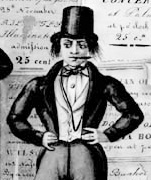The Bowery Culture ExhibitThe Lost Museum Archive

For two decades in pre Civil War New York City, the Bowery b’hoy (and his “g’hal”) were icons of working-class high spirits and urban America’s feisty democratic culture. A main east side thoroughfare, by the late 1830s the Bowery was best known for its entertainment possibilities, which included cheap dancehalls, dime museums, billiard salons, rowdy theaters, performing animals, and boxing. The Bowery b’hoy was based on the dress and behavior of actual New Yorkers, but he became famous as a character “type” depicted in print and onstage, a symbolic figure that represented the rise of commercial culture and decline in the status of skilled trades that were altering social relations in the mid-nineteenth century city. Lampooning the dress and manners of the aristocracy, the Bowery characters provided ample material for, in historian Peter Buckley’s words, the “comedy of a culture in rapid transition.” Under Barnum’s proprietorship in the 1840s and early 1850s, the American Museum presented sensational exhibits and raucous entertainments that attracted a working-class, Bowery crowd. But Barnum increasingly attempted to attract a more respectable audience of middle-class men, women, and children to the Museum, replacing blackface minstrel shows with moral dramas on the stage and banning alcohol in favor of ice water on the refreshment stand.